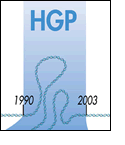Return to Online
Education Kit
|
 |
 |
 Previous Event | Next Event Previous Event | Next Event 
2003: Human Genome Project Completed

The International Human Genome Sequencing Consortium announced the successful completion of the Human Genome Project more than two years ahead of schedule and under budget. The primary goal of the project was to produce a reference sequence of the human genome. In 2001, the international consortium published a draft sequence. Project scientists then worked to convert the draft sequence into finished sequence. Finished sequenced is defined to mean that there is no more than one error in 10,000 bases sequenced and the sequence is nearly continuous, having just a small number of short gaps. Some areas of the genome are difficult, if not impossible, to sequence using current technology. Fortunately, these areas are few and far between and most probably do not contain genes. The finished sequence announced by the international consortium covers 99 percent of the genome and is accurate to 99.99 percent.
More Information
Scientists working on the Human Genome Project realized that to make sense out of the human genome sequence they would need to test their ideas using model organisms. For this reason and despite its name, the Human Genome Project also sequenced the genomes of other organisms. Prior to the completion of the human genome, researchers sequenced the genomes of the bacterium E. coli, yeast, fruit fly, the nematode worm C. elegans and the mouse. These organisms were selected because they possess attributes that make them desirable for laboratory experimentation.
Already genomic scientists are working to mine the human genome for useful information. Experts have recommended that the following challenges be met if society is to maximize its benefits from genomic science:
- Develop new tools to identify the genetic contributions to common diseases such as cancer, diabetes and heart disease.
- Develop new methods for early disease diagnosis.
- Develop new technologies that can sequence an individual’s genome for less than $1,000.
- Provide wider access to the tools of “chemical genomics” to enhance understanding of biochemical pathways and speed the development of new drugs.
Reference:
A Vision for the Future of Genomics Research
A scientific report that describes the future of the field of genomics.
 Previous Event | Next Event Previous Event | Next Event 
Last Reviewed: April 17, 2008
|

